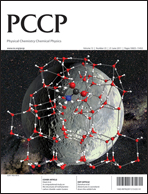Molecular level interactions are of crucial importance for the transport properties and overall performance of ion conducting electrolytes. In this work we explore ion–ion and ion–solvent interactions in liquid and solid polymer electrolytes of lithium 4,5-dicyano-(2-trifluoromethyl)imidazolide (LiTDI)—a promising salt for lithium battery applications—using Raman spectroscopy and density functional theory calculations. High concentrations of ion associates are found in LiTDI:acetonitrile electrolytes, the vibrational signatures of which are transferable to PEO-based LiTDI electrolytes. The origins of the spectroscopic changes are interpreted by comparing experimental spectra with simulated Raman spectra of model structures. Simple ion pair models in vacuum identify the imidazole nitrogen atom of the TDI anion to be the most important coordination site for Li+, however, including implicit or explicit solvent effects lead to qualitative changes in the coordination geometry and improved correlation of experimental and simulated Raman spectra. To model larger aggregates, solvent effects are found to be crucial, and we finally suggest possible triplet and dimer ionic structures in the investigated electrolytes. In addition, the effects of introducing water into the electrolytes—via a hydrate form of LiTDI—are discussed.

You have access to this article
 Please wait while we load your content...
Something went wrong. Try again?
Please wait while we load your content...
Something went wrong. Try again?


 Please wait while we load your content...
Please wait while we load your content...